Post harvest loss is one of the biggest problems affecting economic growth globally. The FAO (Food and Agriculture Organization) estimates that 1/3rd of loss in the food products occur every year. The loss depends upon the type of crop that is to be cultivated. As the fruits and vegetables are perishable, so their chances are more to get spoiled or degraded.
Post-harvest losses mainly occur in developed and developing countries. Food losses occur naturally by the microbial attack, enzymatic action, and chemical degradation. A major portion of the food is wasted at the stage of quality standards. A food item is either selected or rejected based on the parameters like shape, appearance and packaging.
The increase in population has limited the food resources, due to which the management of the food loss is now of utmost concern. You will learn the definition, aim, factors affecting, types and management of the post harvest loss in this context. Also, the estimated loss and the sources responsible for causing post harvest losses are explained.
Content: Post Harvest Loss
Definition of Post Harvest Loss
Post-harvest loss can define as the loss from the stage of harvesting to the stage of consumption resulting from qualitative loss, quantitative loss and the food waste (by the consumers) altogether.
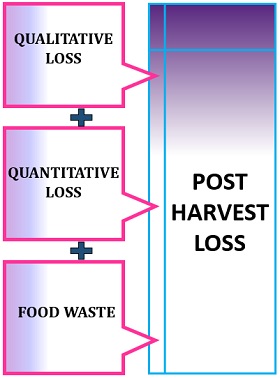
What is Food Waste?
Food waste is the subcategory included in the post-harvest losses that occur after marketing the food product to the consumers. Thus, it can be defined as the wastage of edible food that has been unutilized by the consumers. Food waste is strongly linked with the consumer’s behaviour, and it occurs by several ways like:
- Consumer’s refusal to the retailer in purchasing the product.
- Discarding of leftover food.
What is Food Loss?
Food loss in the post-harvesting chain results from the loss during the harvesting stage to food marketing at the consumers level. It occurs as a result of both qualitative and quantitative food loss.
- Quantitative food loss occurs due to weight loss, spillage of crops, microbial attack and pest attack.
- Qualitative food loss occurs as a result of nutrient loss, undesirable change (in taste and texture), presence of excreta (like birds and rodents) and contamination by mycotoxin.
The Objectives of Post Harvest Losses
Post-harvest technology targets the following attributes:
- Maintenance of food quality: The quality of food is maintained without altering the appearance, texture, weight, flavour, nutritive value, and other food properties.
- Food safety: Post harvest technology maintains food safety by keeping the food items at proper storage conditions to avoid contamination.
- Reduction in food loss: The technique also targets to reduce the food loss between the period of harvesting and consumption by improving harvesting, storage, transportation facilities and marketing policies.
- Reduction of food waste: It also minimizes the food wastage at the consumer’s level by improving marketing skills and proper distribution of the product.
- Effective management of the post-harvest losses.
- Promotion: It includes the promotion of both small and large scale production of crops.
Factors Affecting
There are some primary and secondary factors, which affect the post-harvest loss of food products.
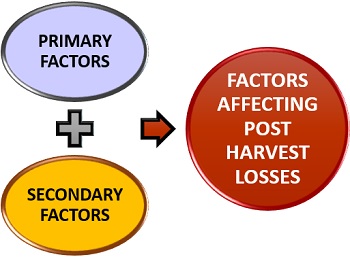
Primary Factors
- Mechanical loss is caused by poor handling from the stage of harvesting to storage.
- Microbial action is caused by microorganisms like bacteria, fungi, and yeasts etc., which readily affects the perishable food crops like fruits and vegetables.
- Environmental factors like temperature and humidity are the two important factors primarily responsible for the post-harvest losses.
Secondary Factors
- Inadequate harvesting methods
- Incomplete drying before threshing
- Inadequate storage facilities
- Longer shipment
- Longer distribution period
- Lack of market access and policies
Types of Post Harvest Losses
Based on the different stages of post-harvesting, post harvest loss is categorized into the following types:

Direct and indirect loss
Direct loss is a food loss, which occurs by spillage of crops, attack of microbes and pests. Indirect loss is a type of food waste that occurs at the consumer level like consumers’ refusal to purchase, infrequent visits to the market etc.
Weight loss
It is the observable loss that can be measured by observing the reduction in the food’s moisture content. An abnormal increase in the weight of food through moisture absorption is also a cause of food loss. The food items kept in the open area retain moisture from the surrounding. Examples: Prolonged storage, shrinkage, consumption by insects, poor packaging are the reasons, which can lead to weight loss.
Food loss
It occurs as a result of the qualitative and quantitative loss of the food crop.
- Qualitative food loss: It deteriorates the product’s quality that results after the degradation of the food nutrients, texture, taste, shape etc.
Example: The nutritional factors like carbohydrates, proteins, vitamins act as prey for different parasites like:- Weevils feed inside the seed containing high carbohydrate content.
- Some insects attack the cereal cover that is rich in vitamins.
- Moulds and bacteria attack on perishable foods as they have a high moisture content and favours the microbial growth.
- Loss due to the soluble excreta of pests, pesticides, and pathogenic organisms.
- Quantitative food loss: It reduces the quantity of a product that results due to the weight loss by factors like an attack of insects, birds, rodents, moulds etc.
Example: Staple foods (like rice, maize, wheat etc.) are the target of rodents and insects.
Seed viability loss
It occurs due to poor storage conditions or preservation methods. Some pests, atmospheric conditions (temperature, moisture, light etc.) are the reasons for the seed viability loss, which leads to the excessive respiration of the food product.
Commercial loss
It ultimately leads to economic and monetary loss due to the following reasons like:
- Customer refusal to the retailer to buy a product
- Rejection by the quality standard team
- Both qualitative and quantitative loss
- And, all the above factors which are mentioned above can be the reason for the commercial loss.
Irreducible loss
It occurs by the excessive respiration of the product, mechanical rubbing of the grains, shrinkage in the food product, mechanical injuries etc. The extra production may compensate for this loss. In simple words, we can say the production rate must be higher than that of losses.
Example: For the loss of 20% in food, the production rate must be increased to the rate of 25%. Likewise, for the loss of 40%, the production rate must be increased to 66%.
Estimated Loss and Causes
The post-harvest chain involves several stages where a crop is harvested from the field to the final stage where a product is transported to the retailer market. Post-harvesting is usually done in a small as well as large scale production.
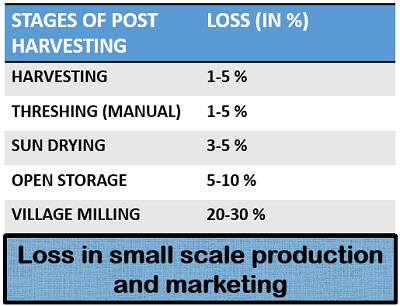
During the whole phase of the post-harvesting chain, there is about 10-30% food loss that occurs in small scale production as well as large scale production.

Causes
Causes of total food loss from the stage of harvesting to the consumers are mentioned below.
- During harvesting: Poor production processes and climatic conditions are the two main causes that may affect the crop at the harvesting stage.
- At the stage of food storage: Microbial attack, insect attack, improper handling, humidity, temperature etc. are some causes that can affect the crop during storage.
- In the food processing stage: Discarding of mechanical injured food, substandard food product, visual-based rejection of product etc. mainly contributes to the food loss.
- At the stage of packaging: Packaging failures and lack of packaging services are the two main causes.
- In the stage of marketing: Improper portioning, supersizing, dented cans are the reason which contributes to poor marketing and ultimately to the food loss.
- At the stage of consumption: The leftovers, impulse buying, infrequent market visits etc. are the reasons which lead to the food waste at the consumer’s level.
Management of Post Harvest Losses
The following control measures can minimize the chances of post harvest losses:
- You must harvest the crop at the correct maturity state.
- For fruits and vegetables, the water should be sanitized with sodium hypochlorite, bleach etc. before dunking into the tank.
- Water used for the irrigation purpose must not be too cold, as the seed germination requires a mild temperature. High temperature may result in soft rot and other crop diseases.
- Discard the mechanically injured food products, as it can favour the entry of pathogenic microorganisms.
- Harvesting should be done in cooler temperature for the perishable products, and the products should be directly transferred to the storage areas after the harvesting.
- Threshing of grains should be handled properly.
- It would be best if you dried the grains completely before transportation to the storage areas.
- The storage areas should be highly sanitized, and there should be proper ventilation and cleaning.
- The product packaging must obey the quality standards considering the following attributes like the shape, weight, nutritional value, etc.
- The transportation to the market retailers should not be at long distance, as there may food spillage, the decay of the food product etc. may consequence.
Conclusion
Therefore, the term post-harvesting is the second stage after pre harvesting process. In the post-harvesting of grains, a chain of several stages is involved as you can see in the diagram below.
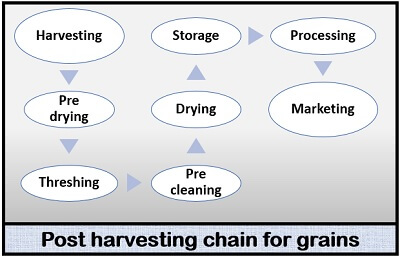
For the post-harvesting of fruits and vegetables, several stages are involved as given in the diagram below.

Many forms of food losses may occur during the stages of post-harvesting, which we have discussed above. To prevent post-harvest losses, we should implement corrective control measures to avoid qualitative loss, quantitative loss, and food waste by the consumers.
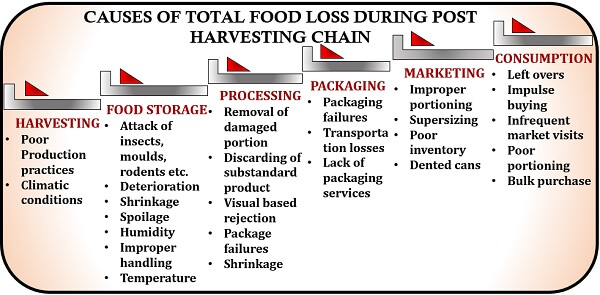
I was scrolling through your articles and i saw the good works you are putting on your website. It’s like i haven’t seen an article like yours before. I will be visiting your website more frequently, thank you.
Good stuff, i am working on my thesis on post-harvest losses and i can only say that your article was very informative. God Bless you!
Thank you
wow
It have me broaden my mind on my work , thanks